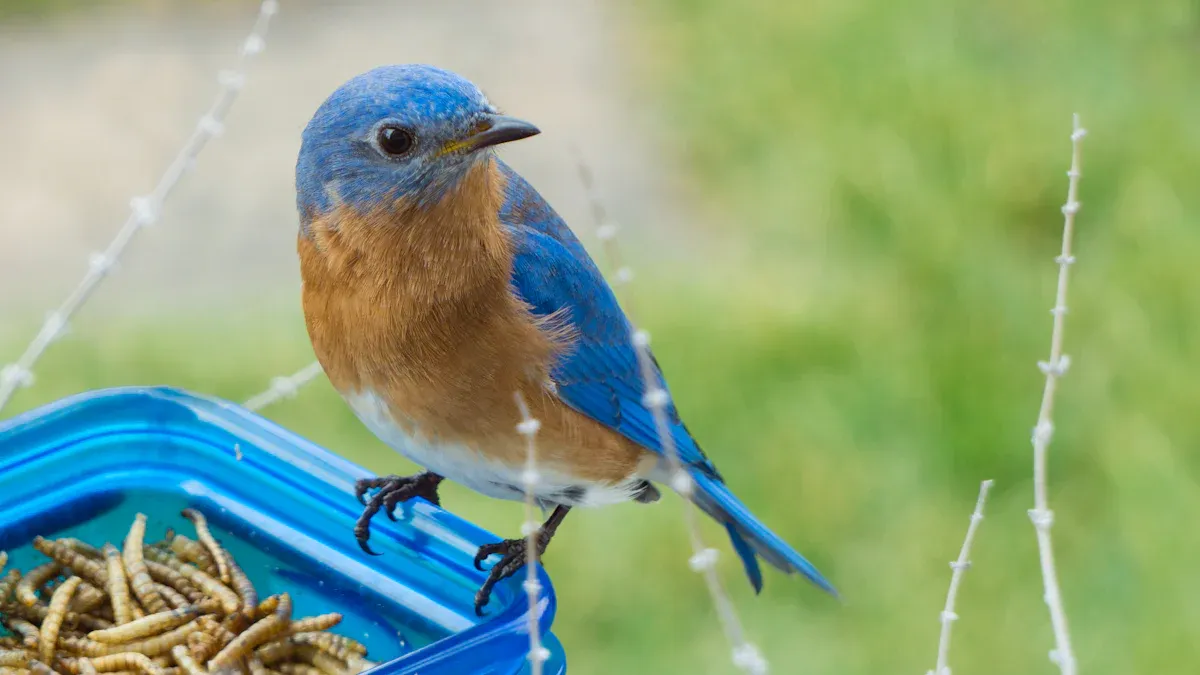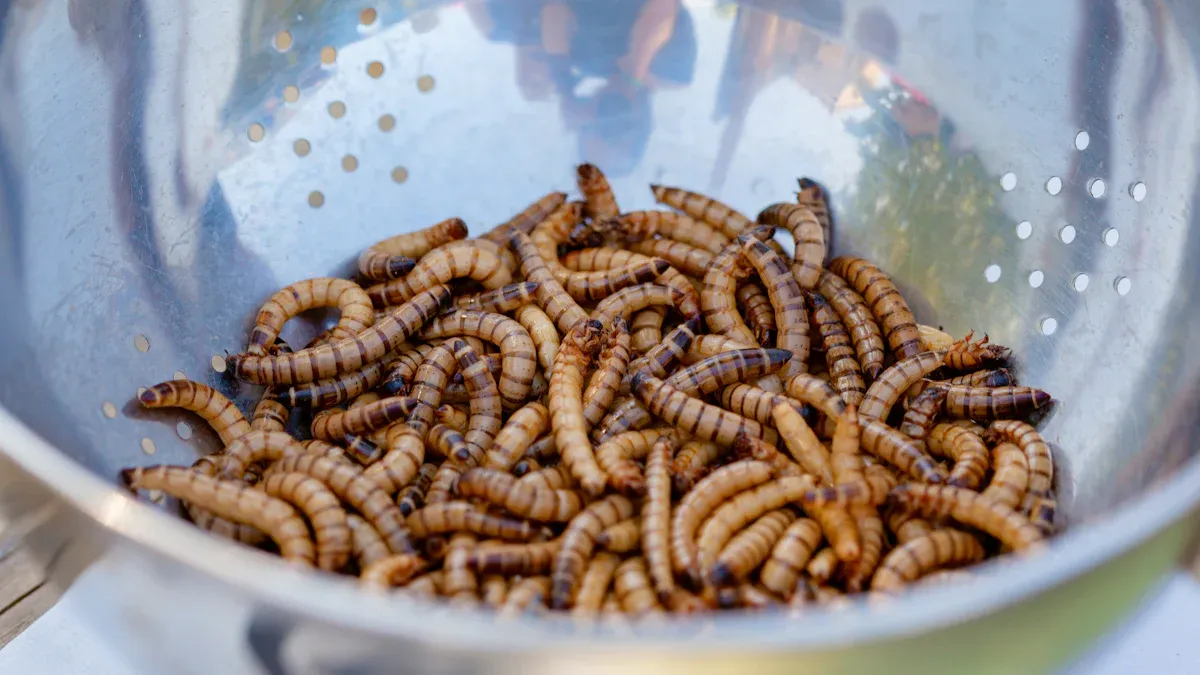
Birds often struggle to find food during scarce seasons, but dried mealworms offer a solution. Packed with protein, healthy fats, and essential nutrients, they fuel birds with the energy they need to thrive. Dried Mealworms Bird Nutrition plays a vital role in supporting their health, growth, and survival when natural food sources are limited.
Key Takeaways
- Dried mealworms give birds protein and fats for energy.
- These help birds stay strong during times when food is scarce.
- Eating dried mealworms keeps feathers healthy and helps with molting.
- This ensures birds can stay warm and fly well.
- Adding dried mealworms with other foods makes a balanced diet.
- This attracts many bird types and keeps them healthy.
Nutritional Composition of Dried Mealworms Bird Nutrition

High Protein Content for Energy and Growth
Protein is essential for birds, especially during growth and breeding seasons. Dried mealworms are an excellent source of protein, containing about 50% protein by weight. This high protein content helps birds build strong muscles, repair tissues, and maintain their overall health. Young birds benefit the most, as protein supports their rapid growth and development. Adult birds also rely on protein to stay active and meet their energy demands.
Birds that consume dried mealworms often show increased vitality. Whether they’re flying long distances or foraging for food, the protein in mealworms gives them the strength they need. Adding dried mealworms to their diet ensures they get a reliable source of this vital nutrient, even when other protein-rich foods are unavailable.
Healthy Fats for Sustained Energy
Fats play a crucial role in providing birds with long-lasting energy. Dried mealworms are rich in healthy fats, which act as a concentrated energy source. These fats are especially important during colder months when birds need extra energy to stay warm. Birds burn calories quickly, and the fats in mealworms help them maintain their energy levels throughout the day.
For migratory birds, fat reserves are critical. They rely on these reserves to fuel their long journeys. By eating dried mealworms, they can stock up on the energy they need to travel great distances. Even non-migratory birds benefit, as the fats help them survive harsh weather and limited food availability.
Essential Nutrients for Overall Bird Health
Dried mealworms are more than just protein and fat. They also contain essential nutrients like vitamins and minerals that support a bird’s overall health. These nutrients contribute to stronger bones, healthier feathers, and a robust immune system. For example, the calcium in mealworms helps birds develop sturdy bones and eggshells, while other minerals aid in metabolic processes.
Feather health is another area where these nutrients shine. Birds need healthy feathers for insulation and flight. The nutrients in dried mealworms promote feather growth and repair, which is especially important during molting seasons. By including dried mealworms in their diet, birds can maintain their health and thrive, even in challenging conditions.
Tip: To maximize the benefits of dried mealworms, offer them alongside other bird foods like seeds and fruits. This creates a balanced diet that meets all of a bird’s nutritional needs.
Benefits of Dried Mealworms for Birds
Meeting Energy Demands During Scarce Seasons
Birds face significant challenges during seasons when food is scarce. They need a reliable energy source to survive and stay active. Dried mealworms provide an excellent solution. Their high protein and fat content make them a concentrated energy source that fuels birds throughout the day. Whether birds are foraging, flying, or keeping warm in colder months, dried mealworms help meet their energy demands.
For migratory birds, this energy boost is even more critical. Long-distance flights require immense stamina, and dried mealworms help them build the reserves they need. Even non-migratory birds benefit from this nutrient-rich food, especially when natural food sources like insects and seeds are unavailable.
Tip: Place dried mealworms in feeders or scatter them on the ground to make them easily accessible to birds during tough seasons.
Supporting Feather Health and Molting
Feathers play a vital role in a bird’s life. They provide insulation, aid in flight, and even help with camouflage. However, feathers wear out over time and need replacement. This process, called molting, requires a lot of energy and nutrients. Dried mealworms are packed with the protein and essential nutrients birds need to grow strong, healthy feathers.
During molting, birds often look for foods that can support feather regeneration. Dried mealworms offer the perfect balance of nutrients to aid this process. They help birds maintain their insulation and flight capabilities, even during challenging times. Healthy feathers also improve a bird’s ability to escape predators and adapt to its environment.
Note: Offering dried mealworms during molting seasons can significantly improve a bird’s feather quality and overall health.
Enhancing Reproductive Success in Birds
Reproduction is one of the most energy-intensive periods in a bird’s life. From building nests to laying eggs and feeding chicks, birds need a nutrient-rich diet to succeed. Dried mealworms play a crucial role in supporting reproductive health. Their high protein content helps female birds produce strong eggs with sturdy shells. The calcium and other nutrients in mealworms also contribute to the development of healthy chicks.
Parent birds benefit as well. Feeding on dried mealworms gives them the energy to care for their young and defend their nests. Chicks that consume mealworms grow faster and develop stronger bodies, increasing their chances of survival. By including dried mealworms in their diet, birds can thrive during the breeding season and raise healthy offspring.
Fun Fact: Many bird species, like bluebirds and robins, are particularly fond of dried mealworms and will return to feeders that offer them regularly.
How to Incorporate Dried Mealworms into a Bird’s Diet

Tips for Feeding Dried Mealworms to Wild Birds
Feeding dried mealworms to wild birds can be simple and rewarding. Start by placing them in a bird feeder or scattering them on the ground. Birds like robins and bluebirds are quick to notice this tasty treat. To attract more birds, try mixing mealworms with seeds or fruits. This combination creates a balanced diet that appeals to a variety of species.
It’s important to consider the needs of young birds. Newly hatched nestlings rely on moisture-rich foods provided by their parents. Since dried mealworms lack moisture, they may not be suitable for very young birds.
Dried worms provide less nutritional value and contain little to no moisture, which can be injurious when fed to newly hatched nestlings; all the moisture they acquire comes from the food supplied to them by the adults, so moisture-rich foods are essential early in their lives.
To address this, soak dried mealworms in water before offering them. This simple step adds moisture and makes them easier to digest.
Recommended Portions and Feeding Frequency
Portion size matters when feeding dried mealworms. A handful of mealworms is usually enough for a small group of birds. Avoid overfeeding, as leftover food can attract pests. Offer mealworms once or twice a day, preferably in the morning and late afternoon. Birds are most active during these times and will appreciate the extra energy boost.
For larger bird populations, consider increasing the portion size gradually. Monitor how much the birds consume and adjust accordingly. This ensures they get enough food without waste.
Combining Dried Mealworms with Other Bird Foods
Dried mealworms work well with other bird foods. Combine them with seeds, nuts, or suet to create a nutrient-packed mix. This variety not only meets the birds’ dietary needs but also attracts a wider range of species.
For an extra treat, mix mealworms with fresh fruits like berries or apple slices. This combination provides a balance of protein, fats, and natural sugars. Birds will flock to feeders offering such a diverse menu.
By incorporating dried mealworms into their diet, birds can enjoy the benefits of Dried Mealworms Bird Nutrition while thriving in challenging conditions.
Sustainability and Accessibility of Dried Mealworms
A Reliable and Convenient Food Source
Dried mealworms are a dependable food option for birds, especially during seasons when natural resources are scarce. Their long shelf life makes them a practical choice for bird enthusiasts. Unlike fresh insects, dried mealworms don’t spoil quickly, so they can be stored and used over time without waste. This convenience allows bird lovers to keep a steady supply on hand, ensuring their feathered visitors always have access to a nutritious treat.
Bird feeders stocked with dried mealworms often attract a variety of species. From robins to bluebirds, many birds recognize mealworms as a reliable food source. This consistency helps birds maintain their energy levels, even when other food options are unavailable.
Tip: Store dried mealworms in a cool, dry place to preserve their quality and freshness.
Environmentally Friendly and Easy to Store
Mealworms are not only good for birds but also for the planet. They are considered sustainable because they can be raised on organic by-products, reducing waste. Farmers use locally available, contaminant-free substrates to grow mealworms, which minimizes their environmental footprint.
- Mealworms can thrive on organic side-streams, making them an eco-friendly choice.
- They have a long shelf life, which simplifies storage and reduces spoilage.
- Their farming process uses fewer resources compared to traditional livestock.
These characteristics make dried mealworms an environmentally responsible option for bird feeding. Their easy storage also means bird enthusiasts can stock up without worrying about spoilage or space constraints.
Widely Available in Local and Online Markets
Finding dried mealworms is easier than ever. They are widely available in garden centers, pet stores, and even supermarkets. For those who prefer shopping from home, many online retailers offer dried mealworms in various quantities. This accessibility ensures that bird lovers can always find what they need to support their feathered friends.
Online platforms often provide bulk options, which are perfect for those feeding large bird populations. Local stores, on the other hand, allow buyers to pick up smaller quantities for casual feeding. With so many options, anyone can incorporate dried mealworms into their bird-feeding routine.
Fun Fact: Some stores even offer flavored or fortified mealworms to cater to specific bird species!
Dried mealworms are a powerhouse of nutrition for birds, especially during food-scarce seasons. Their protein-rich composition supports feather growth, enhances coloration, and keeps birds feeling full. By including dried mealworms in bird diets, enthusiasts can ensure birds stay healthy, energetic, and ready to thrive. Dried Mealworms Bird Nutrition truly makes a difference.
FAQ
How do I store dried mealworms to keep them fresh?
Store dried mealworms in an airtight container in a cool, dry place. This prevents moisture and pests from spoiling them.
Tip: Refrigeration can extend their shelf life even further!
Can I feed dried mealworms to baby birds?
Baby birds need moisture-rich food. Soak dried mealworms in water before feeding them to ensure they’re soft and easy to digest.
What types of birds eat dried mealworms?
Many birds enjoy dried mealworms, including bluebirds, robins, wrens, and chickadees. They’re a favorite treat for insect-eating species.
🐦 Fun Fact: Even some non-insect-eating birds may try them out of curiosity!


